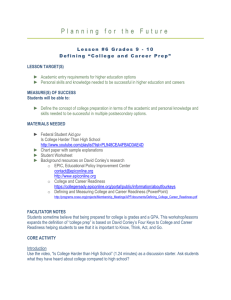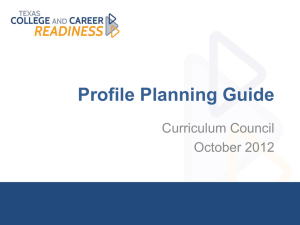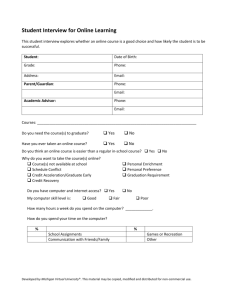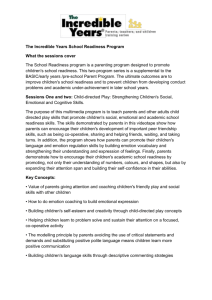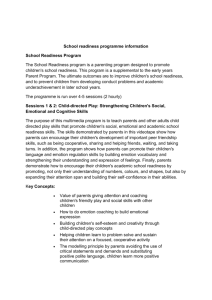Poster Session Transitions Conference Sept. 2010
advertisement
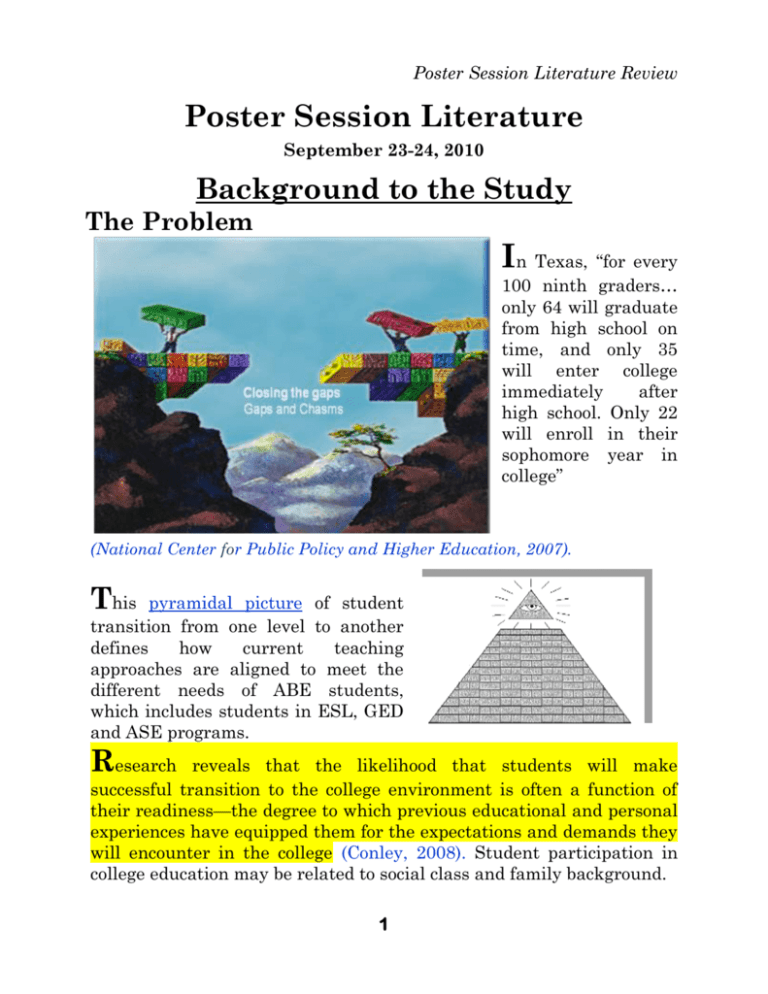
Poster Session Literature Review Poster Session Literature September 23-24, 2010 Background to the Study The Problem In Texas, “for every 100 ninth graders… only 64 will graduate from high school on time, and only 35 will enter college immediately after high school. Only 22 will enroll in their sophomore year in college” (National Center for Public Policy and Higher Education, 2007). This pyramidal picture of student transition from one level to another defines how current teaching approaches are aligned to meet the different needs of ABE students, which includes students in ESL, GED and ASE programs. Research reveals that the likelihood that students will make successful transition to the college environment is often a function of their readiness—the degree to which previous educational and personal experiences have equipped them for the expectations and demands they will encounter in the college (Conley, 2008). Student participation in college education may be related to social class and family background. 1 Poster Session Literature Review Student graduation differences by race Source: Texas Higher Education Coordinating Board retrieved from http://www.texastribune.org/stories/2010/feb/02/graduation-raritycommunity- colleges/ on February 8, 2010. Due to the increasingly changing demographics of the United States, we must focus our efforts on improving postsecondary access and success among those populations who have previously been underrepresented in higher education, namely low-income and minority students, many of whom will be the first in their families to go to college. (The Pell Institute for the Study of Opportunity in Higher Education, 2008, p. 2) 2 Poster Session Literature Review Purpose of the Study To develop a deeper understanding of what college readiness entails, and how professional development based on The Texas College and Career Readiness Standards (CCRS) may be used to guide how programs bring students to college readiness and help the students transition to and succeed in post secondary education. Research Questions This study intended to answer the following research question, what would professional development for postsecondary transition models designed with The Texas College and Career Readiness Standards in mind look like? Specific Research Questions 1. How do ABE programs understand college readiness in relation to CCRS? 2. How do ABE teachers determine when the students are ready to transition and succeed in college? 3. What professional development activities have the programs initiated and how have they modified them to suit the needs of their students? 4. What is the state of professional development for ABE teachers in relation to the CCRS at each of the program sites? 5. How are teachers implementing the CCRS and CrossDisciplinary Standards (CDS) in their classrooms to help their students develop the skills needed to transition and succeed in college? 6. How do teachers and administrators determine the efficacy of their professional development programs? 3 Poster Session Literature Review What does Literature Say about Transitions? Adult education programs face challenges related to how they help students transition to postsecondary education. One such challenge is that teachers may be underprepared to facilitate learning effectively so adult students meet standards for college readiness and college entry requirements. College readiness is one way to understand how ABE programs empower students with “self-awareness and strategies for areas of need, which [in turn may] consequently lead to learners’ increased approaches to the process of learning” (Burchard & Swedzewski 2009, p. 14). Toward a Definition of College Readiness Theorists and researchers provide definitions of college readiness. One way to understand college readiness is to view it as The level of preparation a student needs in order to enroll and succeed, without remediation, in a creditbearing general education course at a post-secondary institution that offers a baccalaureate degree or transfer to a baccalaureate program. Succeed [therefore] is defined as completing entry-level courses at a level of understanding and proficiency that makes it possible for the student to consider taking the next course in the sequence or the next level of course in the subject area. (Conley, 2008, p. 4) How do you define college readiness from your own point of view? 4 Poster Session Literature Review Defining college readiness from Conley’s (2008) perspective, specifying the standards of preparation for students emphasizes a. the need for student-centered approaches, b. accepting and understanding that students may be considered ready to transition into college only when they demonstrate that they know the expectations of the different college level courses and c. that teachers should help students develop and demonstrate specific proficiencies that show that they will be able to cope with content demands from each of the college level courses (Conley, 2008; Dembo, & Seli, 2008; Texas Center for the Advancement of Literacy and Learning, 2008; THECB, 2009). These diverse ideas about college readiness reveal that a number of contributing factors need to be considered when defining college readiness including students’ cultural backgrounds, socioeconomic factors, and parents’ educations. This extension of the definition of college readiness suggests that for ABE providers to turn students’ “aspirations into college attainment, [they will] need a clear indication of college readiness and clear performance standards for those indicators.” (Roderick, Nagaoka & Coca, p. 185). Our Working Definition for College Readiness Was adopted from THECB (2008) who view college readiness as those foundational skills that students require to succeed in pursuing a variety of college majors and students’ ability to demonstrate those skills in order “to succeed in entry-level community college and 5 Poster Session Literature Review university courses… [and the ability] to use content knowledge to weigh and analyze important issues and questions in a field of study” (THECB, 2008, p. iii). What this means for college transitions is that there is need to (a) understand students as individuals, (b) foster learning conditions that allow students to build a foundation of college readiness skills, and (c) help students experience postsecondary learning environments and develop an understanding of what to expect as they prepare for postsecondary education. This way of understanding college readiness led us to ask the research question—so, how do teachers understand college readiness and how do they know when their students are college ready? Adult students learn better in collaborative learning communities and they use diverse ideas from other students to scaffold their own understanding of new concepts. They also learn better when they are allowed to solve real life problems. 6 Poster Session Literature Review The Importance of CCRS and CDS 1. Since the standards driven education curriculum was introduced in Texas, it has been observed that both in elementary and middle schools, “test results have improved, especially among students of color, and more students of all backgrounds are entering and completing postsecondary education programs” (THECB, 2009, p. iii). 2. CCRS serve as a compass to help ABE programs, as well as K-12 programs prepare students for college readiness by ensuring that students develop “core knowledge and skills and a foundation in literacy and basic mathematics…[to] help students develop a foundation of skills that they can employ to successfully pursue a variety of college majors” (p. iii). 3. “Generally, the more standards a student can demonstrate successfully [for each subject], the more likely it is that he or she will be college ready” (THECB, 2008, p. iv). (a) This observation implies that students will benefit from mastering the CCRS. (b) It also means that teachers who understand how to determine the presence or absence of CCRS will succeed more with their ABE students. 7 Poster Session Literature Review Many problems besiege our ABE programs. Which problems can you see illustrated in this cartoon? Image content adapted from: http://www.seattlepi.com/horsey/viewbyperson.asp?person=Socrates&id=285 8 Poster Session Literature Review Brief Description of Subject Areas Covered by CCRS CCRS are the KEYS to transitioning and succeeding in post-secondary education 1. CCRS are specified for four key subject areas including English/language arts, Math, Social studies and Science. The English/language arts standards describe what students should be able to do in five different aspects of the subject, including writing, reading, speaking, listening, and research. Mathematics standards require that teachers systematically and intentionally help their students understand mathematics as a way of knowing by developing mathematical reasoning skills in different facets of the subject. Science standards upon successfully graduating from ABE programs, students who can demonstrate proficiency in the ten science standards are considered “ready to explore and appreciate the richness and complexity of the natural world,” and also able to apply different scientific ways of learning and thinking, math applications and scientific ways of communication (THECB, 2008, p. 14). Social Studies standards Teachers help adult education students succeed at college level by ensuring that those students master the cognitive skills to “apply in a systematic manner the fundamental concepts, approaches, and terminologies common to a range of social studies disciplines including history, geography, political science, economics, and sociology” (THECB, 2008, p. 24). 9 Poster Session Literature Review Importance of Cross-disciplinary Standards 1. Cross-disciplinary standards are designed to identify those cross-cutting knowledge and skills that help students to make connections between the four subjects, English, mathematics, science and social studies (Conley, 2008; THECB, 2008). 2. Therefore knowledge of CDS help teachers to develop in their students the ability to apply those learning skills from CCRS across the different content, contexts and subjects’ matter, so they equip ABE students with skills and knowledge to solve problems at college level and also in their workplaces (THECB, 2008). 3. The CDS help students solve problems in school and apply learned theory to solve problems in real life situations. 4. The CDS demystify the college curriculum for students by arming them with key cognitive skills and foundational skills both of which are needed to read, write, research, and present information across disciplines. CDS are divided into two major groups: key cognitive skills and foundational skills. 10 Poster Session Literature Review Key Cognitive Skills CCRS are the KEYS to transitioning and succeeding in post-secondary education ABE students often suffer from an array of cognitive skills deficiencies (Vella, 2002; Conley, 2005; Kamel, 2008) including lack of 1. formal education that may cause them to adopt nontraditional learning styles 2. critical thinking and problem solving skills, rendering them academically unready for college level work 3. lack of good academic habits (Conley, 2005; Kamel, 2008). 4. learning deficiencies compounded by disabilities (if present) and lack of basic skills of reading, writing, and math College readiness refers to skills that students should demonstrate when exiting a program to enter college (THECB, 2008). Teachers should systematically identify their students’ learning needs, and continuously prepare them to meet different content standards and benchmarks for adult learners (Brookfield, 2005; Conley, 2008; Kamel, 2008). 1. Theorists and researchers agree that cognitive skills are important because they shape students’ access to and readiness for college education (Brookfield, 2005; Conley, 2008; Kamel, 2008; THECB, 2008). 2. Cognitive skills empower students to engage in work from a wide range of courses (Van Blerkom, Van Blerkom, & Bertsch, 2006; Conley, 2008; THECB, 2008; Roderick et al., 2009). 3. Because postsecondary education courses present higher level demands for students than high school courses, the development of key cognitive skills is central to successful transitioning of adult students to postsecondary education (Conley, 2008). 11 Poster Session Literature Review Literature identifies six key cognitive areas educators need to develop in students in order for students to be considered cognitively ready to transition into college (Conley, 2005; Conley, 2008; Texas Higher Education Coordinating Board, 2008; Roderick et al., 2009). They include intellectual curiosity, reasoning capacity, problem solving, academic behaviors; collaborative and independent working habits; and academic integrity. (Brookfield, 2005; Conley, 2008; Texas Higher Education Coordinating Board, 2008). Key cognitive skills are important because they promote the ability for students to work on academic assignments both independently and collaboratively (THECB, 2008). Conley (2008), adds that cognitive skills prepare students (a) to be able to capture content from a wide range of courses and (b) for a strong academic cultural shock in which “some students will be far more comfortable than others…but they will all experience some degree of culture shock” (p. 4). When students are cognitively ready to transition to postsecondary education, they should be able to demonstrate five specific behaviors including, problem solving, research, reasoning; argumentation and proof; interpretation, precision and accuracy (Conley, 2008). Research reveals that university professors have named these skills as key determinants for college success (Vella, Berardinelli & Burrow, 1998; Vella, 2002). 12 Poster Session Literature Review Foundational Skills The key foundational skills students should demonstrate include the abilities to (a) read across the curriculum, (b) write across the curriculum, (c) research across the curriculum; (d) collect and use data; and (e) use technology for various purposes including gathering information, organizing, analyzing, managing information, and communicating among many other uses (ACT, 2004; Texas Higher Education Coordinating Board, 2008). In the view of Roderick et al. (2009), foundational skills may also be referred to as core academic or readiness skills because they are “highly valued and are most often cited by college professors and students as the weakest areas of preparation in high school…particularly in the amount and type of reading and writing required and the analytic and thinking skills emphasized.” (2009, p. 190). This observation confirms the view that certain college courses present higher order learning challenges to students, and hence there is a need to prepare them for those challenges by making them aware of their learning strengths and weaknesses. Students who are more aware of their learning strengths and weaknesses demonstrate greater readiness to employ strategies that help them succeed (Van Blerkom D. L., Van Blerkom M. L., & Bertsch, 2006; Buchard & Swerdzewski, 2009). Foundational skills empower students to succeed by making sure that they are ready to manage their learning behaviors—time management, persistence, applying for financial aid, self control, strategic study skills, and the ability to learn collaboratively in teams (Lundell, Higbee, Hipp, & Copeland, 2004; Venezia, Kirst, & Antonio, 2004). 13 Poster Session Literature Review Identified Differences Between Content Standards and the College and Career Readiness Standards Identifiable differences exist between the Texas Adult Education Content Standards and Benchmarks and the Texas College and Career Readiness Standards (CCRS). These differences highlight a need for professional development for ABE teachers, and unless professional development addresses those differences, transition rates for ABE students to postsecondary education will continue to pose problems. Considering the differences between the Texas Adult Education Content Standards and Benchmarks for ABE/ASE and ESL Learners and CCRS in the English/Language Arts area, a side-by-side comparison yields interesting results and observations. a. First, the ABE/ASE Standards overall focus on basic survival skills, while the CCRS are more focused on academic preparation b. Second, the individual standards in the ABE/ASE Standards contain minimal detailed content. On the other hand, the CCRS contain detailed descriptions of the standards and the skills expected c. Third, the ABE/ASE focuses on GED completion while the CCRS focus more on college expectations. d. Fourth, the ABE/ASE Standards are progressively arranged, moving the learner through a series of advancing skills through levels. This is unlike the CCRS which present related but specific skills, each of which must be mastered by students. The question that needs to be answered is What are ABE/ASE programs doing to mesh the differences that exist between these standards? If found, answers to this question may help narrow these differences and provide adult students with teaching-learning experiences that provide opportunities for ABE/ASE and ESL students to develop college readiness skills as detailed in the CCRS standards. 14 Poster Session Literature Review Existing Barriers to College Readiness Literature reveals that students face a number of challenges that make it difficult for them to be college ready or to succeed when they enroll in college (The Pell Institute of Opportunity in Higher Education, 2008). The challenges to college readiness that ABE students face include: a. Some students, especially those from minority backgrounds come from families that have lower academic backgrounds. b. Some adult students do not have financial support to help them concentrate only on academic work, so they will have outside college responsibilities like multiple jobs, children, and other personal commitments that may reduce their commitment to college education. “These factors lower students’ chances of persisting to graduation” (The Pell Institute of Opportunity in Higher Education, 2008). c. Earlier education experiences may not have prepared them well enough for successful college participation. d. They may not have been exposed to social experiences that foster a college readiness culture including— studying in groups, and knowing how to access and use student support services online or in person. e. Teachers may not understand the different ways of knowing of students from diverse demographics. 15 Poster Session Literature Review Suggestions for Breaking the Barriers to College Readiness Various initiatives nationwide— and in Texas in particular— commonly practice and recommend (The Pell Institute of Opportunity in Higher Education, 2008, THECB, 2008). Recommendations include that ABE providers should: a. equip their students with improved academic preparation for college courses by engaging students through access to college preparatory courses and also by exposing them to best practices from teachers who understand college readiness as guided by the working definition in this paper. b. provide strong counseling services that promote a college going culture. c. help promote college transition through bridge and orientation programs that provide advising, tutoring, and mentoring services. d. focus on demystifying college culture for their students by exposing those students to college environments early through college tours. e. Provide and or facilitate access to financial aid. f. help students develop computer skills A closer look at these suggestions reveals that teacher preparation plays a key role in making students ready for college. In the literature reviewed, mathematics seems to be the immediate obstacle students face as they try to earn a GED. However, reading and writing (at a level described in the CCRS) are also vital skills for students to meet both the working definition for college readiness and experience success in college or certification programs. 16 Poster Session Literature Review Towards a PD-Model for Developing Effective College Readiness THCEB 2. 3. 4. 5. provides innovative grant opportunities encouraging ABE providers to address transition into postsecondary education. This THECB funded research project, identified practices that showed evidence of effectiveness including: 1. Introducing students to college culture through by creating partnerships with local universities, intensive courses in core content, and introducing college tours, thus helping to demystify college culture and encourage a collegegoing culture in students. Guiding and counseling, caring for students, employing retention strategies, and providing information related to logistics of applying to and registering in college Aligning the curriculum to college level requirements so that students experience, GED, training and intensive summer programs expose students to realistic college preparation Providing organizational support—giving information about pre-transitional processes and how to apply for funding, Providing cognitive support services and increased training in the use of technology The literature that informed the current research also identified best practices models that can be used to help programs improve. Specific examples included improved test scores—both pre-and posttests on the ASSET, TCOM, and ACCUPLACER increased. They also observed success rates in the intensive programs. There was clear increase in student retention and graduation rates within programs. All programs agreed that the qualitative feedback from students revealed that the students experienced success and personal motivation. 17 Poster Session Literature Review Challenges Faced by ABE Programs In Texas, “for every 100 ninth graders…only 64 will graduate from high school on time and only 35 will enter college immediately after high school. Only 22 will enroll in their sophomore year in college” (National Center for Public Policy and Higher Education, 2007). Participants entering ABE programs often suffer from an array of cognitive skills deficiencies (Vella, 2002; Conley, 2005; Kamel, 2008). 1. A lack of professional development may cause teachers to adopt trial and error teaching styles/approaches. 2. Teachers work in more than one job and this may cause them not to have enough time to dedicate to their students. 3. Lack of proper funding for ABE programs may further hamper ability for administrators to initiate group professional development for their staff (Conley, 2005; Kamel, 2008). As a result, it is important for ABE providers to understand the cognitive skills challenges these students face and empower them to overcome these challenges. These examples represent only a few of the challenges faced by adult learners in Texas. 18 Poster Session Literature Review Summary of Literature Review This study revealed that adult students’ transitions to postsecondary education in the U.S. in general, and Texas in particular, face challenges. Literature pointed out that Texas lags behind most states in successfully transitioning students to postsecondary education. Building on these revelations, this literature review defined college readiness in the context of how it would succeed with the Texas CCRS and CDS as a basis for operating programs in Texas. The importance of the CCRS and CDS to transitions was described. The literature shows that it is important for programs to pay attention to the development of key cognitive skills and foundational skills as a strategy for making students ready for college. One way to do that was to understand the barriers to college readiness and for each program to design strategies for breaking those barriers. On the backdrop of all these findings from literature, the current study constructed a tentative model for helping students to be college ready. Finally, a cursory inspection and comparison of the CCRS/CDS and ABE/ASE Standards reveals shocking and widespread differences. It is these differences in training that result in unsuccessful transition to college by underprepared students. References You can find all the references and other resources at: http://www.tei.education.txstate.edu/transitions.html 19

